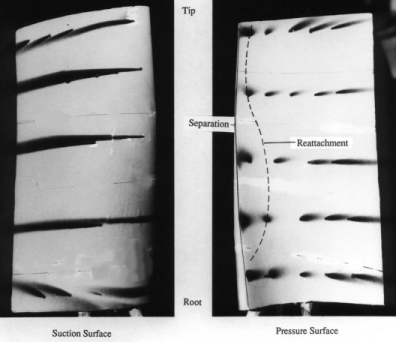The Ammonia and Ozalid paper technique relies upon the chemical reaction that takes place when ammonia gas comes into contact with Ozalid paper. This is one of the few surface flow visualisation techniques available for investigations in the rotating frame. It can also be used to evaluate the film cooling effectiveness in film cooling experiments. The reaction causes a darkening of the paper. Although ammonia (molecular weight of 17 kg/kmol) is much lighter than air (29 kg/kmol) experiments have shown that the buoyancy effects are negligible.
The technique successfully in a number of low speed turbines. In the experiments, the rotor blade and hub surfaces are coated with Ozalid paper, being stuck to the surfaces using double-sided adhesive tape. With the turbine at the desired operating condition, ammonia gas is ejected through static pressure tappings in the surface of the blades and hub. The exit velocity of the ammonia from a tapping should be less than 0.01% of the free stream velocity so that it is unlikely to affect the main flow. The ammonia is fed to the rotor through a rotating pneumatic union. A stroboscope should be used to monitor the developing flow patterns.

Flow visualisation on the rotor of an axial flow turbine are large negative incidence
Figure 3 contains the results of the flow visualisation study obtained on a turbine rotor. On the suction surface, where three dimensional effects are usually most evident, the effects of secondary flow are restricted to the outer and inner parts of the span. The overtip leakage flow can also be seen. At mid-span, the ammonia traces suggest that the flow vectors have no radial component.
This section is in preparation
Papers and a thesis by Stefan Friedrichs, Howard Hodson and others are available in the download section. Press here to down load papers and PhD Theses.
Howard Hodson and Stefan Friedrichs
Home | Current Research | Research Opportunities
Publications | Staff and Students
Research Facilities | Travel Information | Contact Information | Links